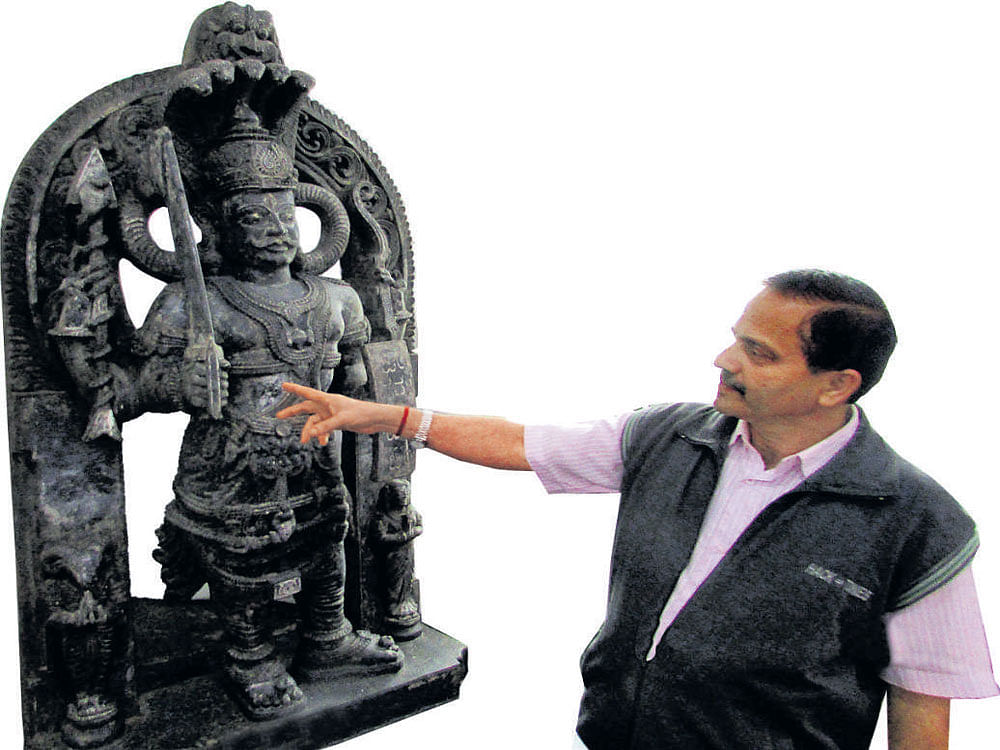
India, a country with rich heritage and culture, is studded with innumerable evidences of a glorious past.
Many manifestations of this can be found in every nook and corner of the country. But a number of these manifestations are either buried, neglected or destroyed.
But in M M Arts and Science College at Sirsi, in Uttara Kannada district, history shines bright in the form of an archaeological museum, ‘Swarna Manjoosha’. With over 50 valuable sculptures and monuments, some of which dating back to sixth century AD, this museum is the brainchild of T S Halemane, an associate professor of the history department in the college.
The museum was initiated in 2010 at the college with the aim of preserving the historical evidences around Sirsi and imparting relevant information to the students of history in the college, thereby facilitating both study and preservation of history. Today, Swarna Manjoosha has got a new building, which was inaugurated recently.
Remnants of the past
Most of the sculptures on display here are stone statues related to Hinduism and Jainism. In addition to these, inscriptions and epigraphs of kings, hero stones, beautiful stone sculptures belonging to the Chalukya, Rashtrakuta, Hanagal Kadamba, Vijayanagar and Keladi kings, earthen pots, earthen bricks, ancient articles related to Yakshagana and many other artefacts are also displayed in this museum.
Each of the stone sculpture is fixed firmly onto a concrete platform. A short information board describes each sculpture, the age it belongs to and the place from where it was brought. Some of the sculptures are in good condition while many are deformed. In some structures, in order to preserve their original form, cement and gum have been used.
Most of the stone sculptures have been collected from places around Sirsi and neighbouring taluks. The collection ranges from a sixth century Vishnu belonging to the Chalukya dynasty to a Veerabhadra statue from recent times. Statues of Balamuri and Edamuri Ganapathi, a statue of Goddess Saraswathi and a statue of the Sun — all belonging to 13th century; Lakshmi carved in white marble (Vijayanagar period); saptamatrikas and Mahishasura Mardini statues of 12th century are some of the statues displayed here.
A 12th-century Shivalinga is the largest among all, standing tall at six feet. It was found in an irrigational dam site. An inscription of the local king Sode Arasappa Nayaka who ruled the area during 17th century is an added attraction here.
Many structures that reflect the Jain heritage of the State can also be found in this museum. A couple of statues of teerthankaras in a sitting posture belonging to the Vijayanagar empire occupy prime location. One statue carved in black stone is the star attraction of the museum.
What’s more, local deities like Choudi, Huliyappa (Tiger God) and Veeerabhadra can be found here. Another interesting part of the museum is the collection of mastigallus and veeragallus. Many of them are over six feet tall and are around 300 years old.
Taking the lead
Talking about how it all started, Halemane says, “The commissioner of the Department of Archaeology, Museums and Heritage, Mysuru, realised the necessity and
importance of such heritage establishments and gave permission to us in the year 2007, which otherwise is quite difficult to obtain. One has to get consent either from the departments concerned or from Archeology Survey of India (ASI) to establish such a museum.”
He adds, “There are many such sculptures all around us lying under the sun, in jungles, rivers and ponds and getting ruined slowly. There is an urgent need to preserve them. In places where I find valuable sculptures and monuments, I persuade local people to donate them to our museum in the larger interest of the public.” With the help of the college management committee, Halemane is trying hard to find neglected evidences of history and shift them to the museum.
“We take extreme care not to hurt anybody’s sentiments during the extraction of such sculptures. But it is quite difficult to persuade people to donate or to obtain consent to shift the artefacts. But after learning about our noble cause, many willingly came forward to donate,” Halemane says.
“The dedication of Halemane in the collection and establishment of the museum is commendable,” states Ganesh Hegde, a faculty member in the college. Venkatramana Hegde, a third year BA student, is proud to have such a museum in the campus. “We can get a practical knowledge of history at the campus itself, which is rare to see,” he says. The museum is not only for the students. It welcomes public visitors too.
Sripad Hegde, a farmer from Sirsi is thrilled to note that several valuable sculptures and statues in the museum are arranged in a systematic manner and each one is named chronologically along with the place from where it was collected from. “The museum takes us back to the historical times,” he beams.
It is high time that such archaeological museums are established at appropriate places as they depict the history of the local area at large.
Deccan Herald is on WhatsApp Channels| Join now for Breaking News & Editor's Picks